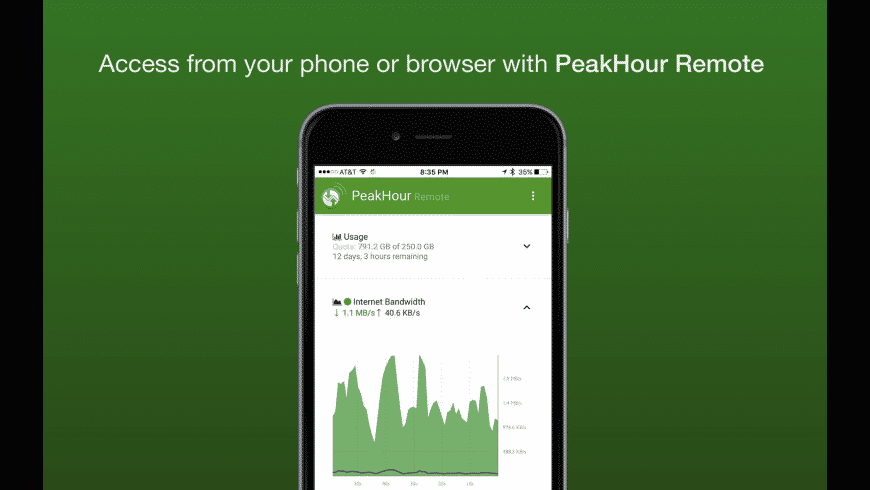Trusted Mac download PeakHour 4.1.10. Virus-free and 100% clean download. Get PeakHour alternative downloads. The easiest network monitor and firewall for Mac. Radio Silence can stop any app from making network connections. Powerful privacy for your Mac. Radio Silence lets you keep a list of apps that aren't allowed to go online. Protect your privacy. Prevent apps from phoning home. Save on bandwidth and data charges. Radio Silence is completely invisible. Peakhour is a beautiful display of network traffic that lives in your menu bar of Mac OS. It provides a snapshot of your Internet activity or WiFi in real time.Peakhour is perfect for monitoring network devices: Internet, WiFi, NAS, servers and more. PeakHour 3.1.5 cracked for Mac – display of network traffic. PeakHour 3 now includes a powerful history engine that stores usage and performance data for as long as you wish. The History view lets you look back at usage and performance over any time period: hours, days, weeks, months or years. Enhanced Real-time PeakHour's real-time view has been enhanced to support zooming and scroll-back. PeakHour 3.1.3 – Visualize and analyze your network traffic. April 14, 2016 PeakHour is a beautiful, real-time network-traffic visualizer that lives in your menu bar.
I’ve detailed my very favorite apps here in 2014 and Dan and I praised more apps last year. I’m not going to restate the stuff mentioned in those stories—yep, still writing this in BBEdit—but here are a few Mac apps that I’ve come to appreciate this past year.
PeakHour 3
Recently Comcast informed me that my home Internet data would be capped at 1TB per month. And it turns out that my family uses about 1.1TB per month on average. So I’m trying to figure out how we’re using that data, but it’s very hard to get a good idea of where the data is going, and when.
I discovered the $6 PeakHour 3, which talks to my SNMP-enabled home router to display charts of our data usage. To get the best idea of usage, I need to leave it running all the time, but since I have a Mac Mini that’s running all the time, that fits the bill. I’m even able to tell PeakHour my data cap and it can give me a sense of how ahead (or behind) we are month to month.
So far, what I’ve learned is that my kids are indeed the voracious Netflix and YouTube streamers that I knew them to be. I may end up paying an extra $50/month for unlimited data, but at least I’ll be well equipped with information about how we’re using our broadband before I get to that point.


iStat Menus
I used to pooh-pooh the idea of keeping little whizzy graphs in my Mac’s menu bar, but in the past year I’ve found value in the $18 iStat Menus 5. As a podcaster I’m trying to control the amount of data I’m using when I’m recording audio or video with other people, and iStat’s network module lets me see how much data my Mac is transferring at any given time. I also monitor the speed of my storage and how much processing power my iMac is using, largely to keep an eye out for unexpected slowdowns, which usually come courtesy of some helpful background process that’s trying to do something utterly unimportant to my task at hand.

iStat Menus is utterly configurable, so you can make it as whizzy or non-whizzy as you like. If you want to know at a glance what your Mac is up to, it’ll take care of you.
Calibre
I don’t love the Calibre ebook software—it’s exactly as clunky as you’d expect an open-source cross-platform software project to be—but it’s free and it works, and that counts for an awful lot. I use Calibre to convert ebooks to various formats. Ever since I bought the Kobo Aura One ebook reader, I’ve used Calibre to convert some of my Kindle books to read on the Aura One’s larger screen. And I use Calibre frequently to convert ePubs into a Kindle-compatible format.
iZotope RX 5
Podcasting’s funny. Some people build themselves a home studio and buy an expensive microphone while other people keep it low cost and can’t escape the hum of a heater or the whine of their laptop fans. Noises like that don’t make for good podcast audio, so the first thing I do before editing a podcast is strip the noise out of the audio files. And for about a year now, I’ve been using the $349 iZotope RX 5 to do the job. No, it’s not cheap—though as I write this it’s on sale for $262—but it’s a pretty amazing collection of tools. Super smash flash 2 download mcleodgaming. The broadband-noise-removal tool is one of my go-to items, but it’s got a de-reverb filter that will take the echo out of noisy rooms and a de-hum filter that will banish even the most persistent buzz from a furnace.
Peak Hour 3 Mac Peak Hour 3 For Macbook Pro
And then there’s the editor app itself, which displays sound not just as waveforms, but with a spectrum view that makes it easy to see areas of noise—saving a whole lot of time.
Could I edit podcasts without iZotope RX 5? Sure I could. But they wouldn’t sound as good—or perhaps more accurately, some of my guests would sound distinctly inferior to others, and that’s not very nice.
Transmit

Sometimes it feels like I move files around for a living. I’m constantly uploading podcasts and image files for redistribution to the big wide world, and that requires a tool to get those files from point A (my Mac) to point B (some server out there in the world). Panic’s $34 Transmit is my tool of choice for these tasks. I’ve got favorites set up for all of my usual destinations, so with a double-click I’ve got access to all my files. If I need to edit a file on my server, I can double-click and it’ll open automatically in my text editor of choice—and when I make changes and type Command-S, Transmit immediately saves it back up to the server. I’ve even built Automator actions to auto-upload images to Six Colors once they’ve been resized and saved in the proper format.
Keyboard Maestro
I had resisted Keyboard Maestro for years. If I couldn’t script something I needed to automate, it couldn’t be done, I thought. But then I realized I had a complex workflow that I was executing every single time I recorded a podcast, and no amount of scripting would be able to model all the mouse clicks that were required as a part of the workflow. So I turned at last to Stairways Software’s Keyboard Maestro, which I’ve used not only to simplify my podcast workflow setup, but to remap keys on my weird clicky keyboard so that they work with the way I use my Mac. I can’t really find anything Keyboard Maestro can’t do. And it’s a lot easier to build something in Keyboard Maestro than it is to write a script—which is a big deal if you’re a person who wouldn’t mind automating a bunch of repetitive tasks on your Mac, but is never going to learn a scripting language.
Loopback
The Mac’s audio routing capabilities should probably be better. There’s no native way to create virtual inputs and outputs and route sound from one app to another. What’s worse, the release of Lion broke almost every sound utility on the platform that was dedicated to working around those limitations.
This year we got a big piece of the puzzle back with the easy to use and reliable Loopback. Combined with Rogue Amoeba’s Audio Hijack, this solves pretty much all of my audio routing problems. With Loopback, you can create virtual inputs and outputs so that you can send different inputs to different places, merge and combine inputs, pretty much anything you want. Is it a utility that appeals to a limited audience? Absolutely. But I’m in the audience, and I love Loopback.

Peak Hour 3 Mac Peak Hour 3 For Macs
If you appreciate articles like this one, support us by becoming a Six Colors subscriber. Subscribers get access to an exclusive podcast, members-only stories, and a special community.